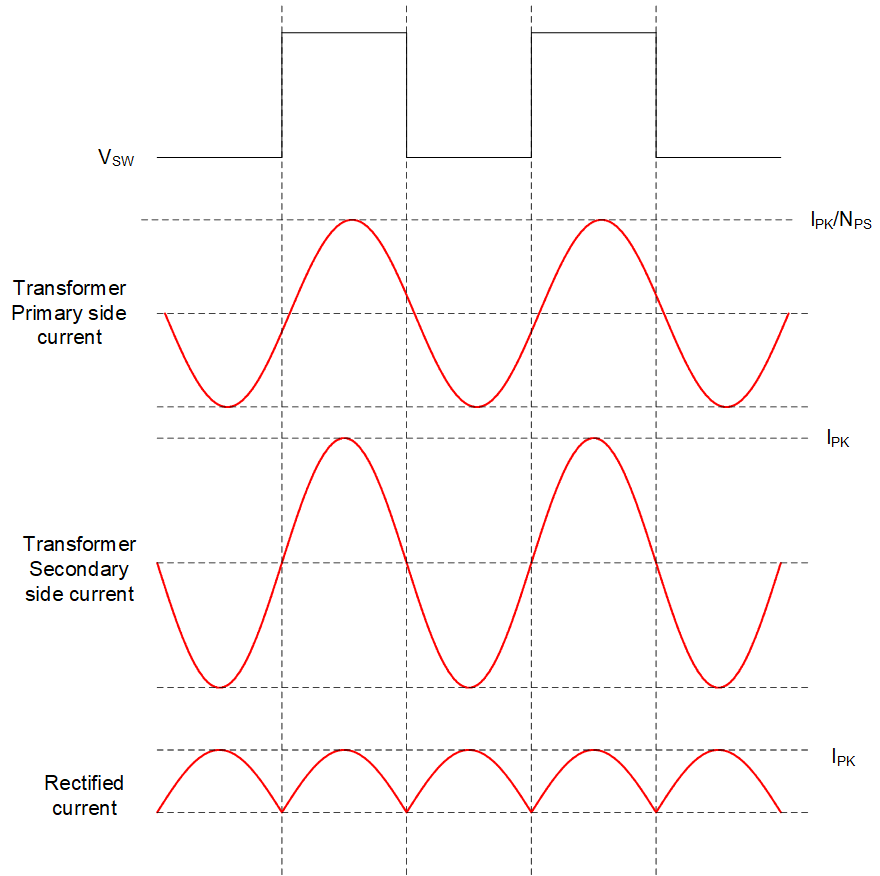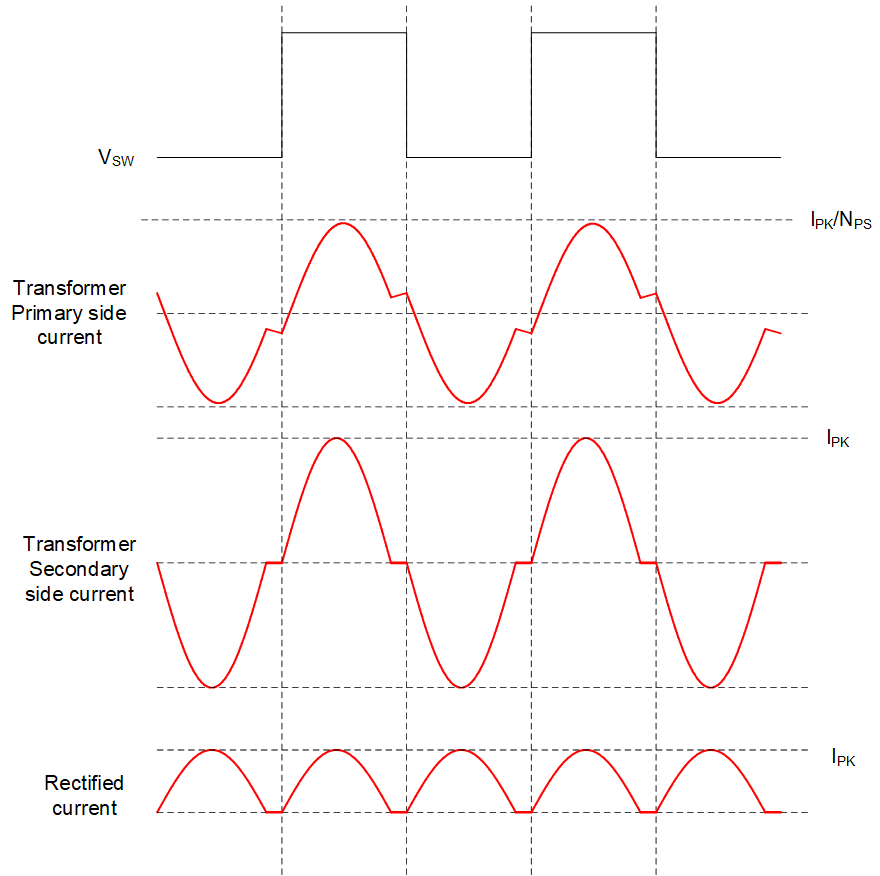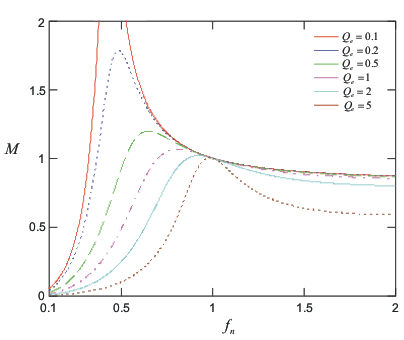-
Bias Supply Design for Isolated Gate Driver Using UCC25800-Q1 Open-Loop LLC Transformer Driver
- Trademarks
- 1 Introduction
- 2 Open-Loop LLC Converter Operation Principle
- 3 Primary-side and Secondary-side Resonant Configurations
- 4 Rectification Methods
- 5 LLC Transformer Design Steps
- 6 Negative Voltage Generation
- 7 Multiple-output Design
- 8 EMI Performance
- 9 Common-Mode Transient Immunity (CMTI)
- 10Summary
- 11Revision History
- IMPORTANT NOTICE
Bias Supply Design for Isolated Gate Driver Using UCC25800-Q1 Open-Loop LLC Transformer Driver
Trademarks
All trademarks are the property of their respective owners.
1 Introduction
UCC25800-Q1 is an open-loop LLC transformer driver. By open-loop control, fixed output to input voltage gain can be achieved through the transformer turns ratio. The open-loop control also provides a simple design and superior noise immunity. The LLC topology utilizes the transformer leakage inductance as its resonant component, allowing the converter to use a transformer with a larger leakage inductance but a much smaller primary-side to secondary-side parasitic capacitance (inter-winding capacitance).
Other topologies, such as flyback or push-pull, require minimum leakage inductance to improve the efficiency, reduce the voltage and current stress, as well as minimize the noise created by the converter. In turn, this type of transformer suffers from larger inter-winding capacitance. When they are used in the gate driver bias supply applications, the high dv/dt from the inverter power stage can be coupled through the transformer inter-winding capacitance to the low-voltage side. This creates a much more severe EMI noise issue. It also puts more challenges on the common-mode transient immunity (CMTI). The open-loop LLC transformer driver solves this issue and provides a low-noise, robust solution for the isolated gate driver bias supplies.
2 Open-Loop LLC Converter Operation Principle
Different from the typical PWM converters, LLC converters adjust the output voltage through varying its switching frequency. It is often called a PFM (Pulse Frequency Modulation) converter. As shown in Figure 2-1, the LLC converter has three resonant elements, the resonant inductor (Lr), the magnetizing inductor (Lm), and the resonant capacitor (Cr). In isolated bias supply designs, the transformer leakage inductance, and the magnetizing inductor can be used as part of the resonant circuit. The only external resonant component is the resonant capacitor.
The resonant frequency of the LLC converter is defined by the series resonance between the resonant inductor (Lr) and the resonant capacitor (Cr), as shown in Equation 1
When its switching frequency is equal or below the resonant frequency, the operation waveforms of LLC converter can be found in Figure 2-2.
When the switching frequency is equal to the resonant frequency, it can be observed that the transformer primary-side current is a sinusoidal shape. The secondary-side current is also a sinusoidal shape but with some phase shift to the primary side current. The phase shift is caused by the transformer magnetizing current. The output current is equal to the rectified transformer secondary-side current. In this operation mode, the resonant tank impedance is equal to zero, and the input and output voltages are connected virtually through the transformer. When the switching frequency moves away from the resonant frequency, the impedance of the resonant tank increases. As a result, the output voltage reduces. However, this only holds true when the switching frequency is higher than the resonant frequency, because the magnetizing inductor never participates the resonant and it doesn't influence the characteristic performance of the resonant circuit.
When the switching frequency is below the resonant frequency, it can be observed that the sinusoidal current becomes discontinuous. In the duration where the sinusoidal shape stops, transformer secondary-side current is equal to zero. During this period, the magnetizing inductor becomes part of the resonant circuit, but the resonant frequency is so low that the current shape appears linear. During this period, the magnetizing inductor stores more energy and transfers it to the secondary side through the resonant capacitor in the following half switching cycle. Therefore, the LLC is able to achieve higher voltage gain.
 |
 |
| (a) Switching frequency is equal to resonant frequency | (b) Switching frequency is below resonant frequency |
The LLC converter voltage gain refers to the relationship between its output voltage and its input voltage. It is defined as Equation 2. In this equation, n is the transformer primary side to secondary side turns ratio and the ½ comes from the half bridge configuration.
As shown in Figure 2-3, the voltage gain is affected by both switching frequency and load. In this set of curves, the switching frequency is normalized with the resonant frequency, which is defined in Equation 1, and Equation 3. The load can be normalized with the characteristic impedance and defined as Equation 4. Here, fs is the switching frequency.
 Figure 2-3 LLC Converter Voltage Gain
Figure 2-3 LLC Converter Voltage GainFrom this set of gain curves, at the resonant frequency, regardless of load conditions, the converter has a gain equal to 1, which means the relationship between the input and output voltage is only determined by the transformer turns ratio. This can be simply understood by the impedance of the resonant tank (Lr and Cr) is equal to zero at the resonant frequency. The input and output voltages are directly connected together virtually through the transformer.
If the LLC converter operates with a fixed switching frequency equal to the resonant frequency, the LLC converter is able to deliver a fixed voltage gain, with different load conditions. With a fixed input voltage, a fixed output voltage can be achieved.
3 Primary-side and Secondary-side Resonant Configurations
In Figure 2-1, the resonant capacitor is on the primary side. From its gain curves, it can be observed when the switching frequency is below the resonant frequency, the converter voltage gain rises. This occurs because the energy that is stored in the magnetizing inductor is transferred to the secondary side in each half-switching cycle. The lower the switching frequency, the more energy is stored in the magnetizing inductor. Therefore the voltage gain keeps going up.
When the resonant capacitor is moved on the secondary side, the gain curves are changed. One example of using secondary-side resonant is shown in Figure 3-1.
Putting the resonant capacitor on the secondary side, when the switching frequency is below the resonant frequency, the energy stored in the magnetizing inductance can no longer be transferred to the secondary side. Instead, the energy is fed back to the input source. Due to this behavior, the voltage gain of the secondary-side resonant becomes flat when the switching frequency is below the resonant frequency, as shown in Figure 3-2.
| (a) Primary-side Resonant | (b) Secondary-side Resonant |
Based on these curves, we can see if the LLC converter is operating with a fixed switching frequency and that frequency is slightly below the resonant frequency, the voltage gain is fixed, regardless of the frequency or the load condition, which means with a fixed input voltage, we get a fixed output voltage. This property also helps to maintain constant output voltage with the tolerances on the resonant components, which is equivalent to the switching frequency variation.
4 Rectification Methods
Besides the transformer turns-ratio, the LLC converter voltage gain is also affected by the rectification structure. In this section, a few rectification methods are presented and designers can select the one according to their cost structure from the components. Because the primary-side circuit remains the same, the description only focuses on the secondary-side circuit.
4.1 One Resonant Capacitor, Voltage Doubler
In this configuration, only one capacitor Cr is needed for the resonant capacitor. There is a DC voltage offset on the resonant capacitor and the voltage doubling is achieved through the transformer voltage in series with the DC offset of the resonant capacitor. When the transformer secondary-side voltage is positive, it adds together with the resonant capacitor offset voltage, diode D1 is conducting, and the transformer delivers energy to the output. When the transformer voltage is negative, D1 is off and D2 is conducting. In this way, the output capacitor Cout is refreshed in one half of the switching cycle. In the other half switching cycle, the output capacitor gets no energy from the transformer and supplies the load using its stored energy. The output capacitor Cout should be much larger (> 10 times) than the resonant capacitor Cr. Or in other words, the output capacitor Cout can be considered as a high-frequency short at the switching frequency.